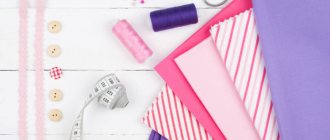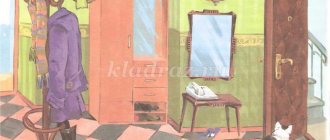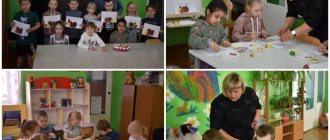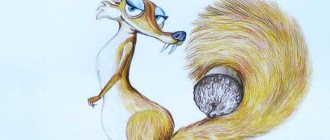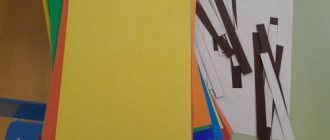On the topic: methodological developments, presentations and notes
Often, not everyone in their preschool educational institutions can purchase the necessary equipment; unfortunately, insufficient funding in our rural areas is progressing. Maybe someone will find my ideas on sports events useful.
Prevention of childhood injuries is one of the most important tasks of modern society, which must be achieved primarily by observing safety precautions in physical education classes.
The didactic game develops visual attention and logical thinking. It will also help consolidate children’s knowledge about different sports, athletes, and sports attributes.
Presentation of work experience.
The material is intended for children of senior preschool age. Can be used in educational activities and in organizing leisure time.
SOD summary for the production of collective work using the 3D appliqué technique “Sport - health, sport - game”.
Tatyana Titova Summary of SOD for the production of collective work using the technique of volumetric application “Sport - health, sport - game”
MAGAZINE Preschooler.RF
Summary of educational activities on application in the senior group “Winnie the Pooh” using health-saving technologyMunicipal autonomous preschool educational institution of the municipal formation of Krasnodar "Center - kindergarten No. 182"
Educator: Perminova A.A.
Tasks:
1. Educational:
- Teach children to create a three-dimensional application of a toy from parts, correctly conveying their relative size.
- mastering cutting techniques, using various methods of attaching material to the background to obtain a volumetric applique.
2. Developmental:
- Develop creative abilities; develop visual control of hand actions, give each child the opportunity to exercise independence in choosing ways to decorate their work.
3. Educational:
- Cultivate friendly attitudes towards others; to generate interest in the application based on the model.
- Strengthen the ability to cut out parts of round and oval shapes, carefully paste the image, and arrange it beautifully on a sheet of paper.
Equipment: scissors, stand for scissors, brush, socket with paste, napkin, stand for brush, box for scraps, tray with parts for toys, oilcloth, yellow cardboard the size of a landscape sheet, sample, natural material (watermelon seeds, melon), buttons.
Progress of the lesson.
Educator:
-Guys, a letter came to our group, and from whom you will find out when you guess the riddle:
He is cheerful and gentle
This cute weirdo
For him, a walk is a holiday
And I have a special scent for honey
This is a plush prankster
Little bear. (Winnie the Pooh)
-Let's read the letter, what does he write? “Dear guys, please take a lot of my photos, I want to give them to my friends, I need to do it before winter. Thank you in advance Winnie the Pooh"
Guys, why is he asking to do it before winter? (bears sleep in winter) where do they sleep? (in the den)
In order for the photos to turn out well, let's look at it carefully.
Is the piece of paper positioned vertically or horizontally? (vertical)
In which part of the sheet is the image of Winnie the Pooh? (in the middle of the sheet)
What body parts does the Winnie the Pooh image consist of? (head, torso, upper and lower paws)
What details are there on the head? (ears, nose, mouth, eyes)
What shape is the head? (round)
Are there body parts of the same shape? (torso)
What geometric shape do the paws resemble? (oval), are there objects of the same shape in the photograph (balloon). What shape do the ears look like? (semicircle)
From which square will we cut the body? Why do you think so? (it's large) Show it on the easel.
What size square do we need for the head? (slightly less)
What detail should we start taking photos with? (from the body)
In what part of the sheet will the body be located? (slightly below the middle of the sheet)
Where will the head be located? (in the upper part of the body, on the head - ears)
Where will the upper legs be located? (right and left of the body, and the lower legs in the lower part of the body)
Notice how the teddy bear's paws move, how should you glue the parts? (glue the tip of the part)
Now that we have looked at the image of the teddy bear, let's remember how to cut out the parts (sit at the tables)
I show and explain how to cut a circle from a square.
Who can tell me how to fold a rectangle to make two squares? (in half) what can we cut out of the square? (ears), how? (round top corners)
And in order for the paws to be the same size, you need to fold a rectangular sheet of paper in half and in half again and cut out one part, you will get 4 oval-shaped paws.
How to cut an oval from a rectangle? (round all four corners).
Where do we start? (cut out all the details, lay out the image on a sheet of paper and then paste it on)
Guys, you will find the details of the face (nose, mouth, eyes) on the tray, which are made and, if you have time, you can make grass and a balloon.
We've looked at everything, I'm sure you'll take wonderful photos.
Get to work.
After cutting out all the parts
physical education minute
A bear wanders through the forest, walking from oak to oak. (Waddle)
He finds honey in the hollows and puts it in his mouth. ( "Get" honey with your hand)
The clubfoot licks the paw of a sweet tooth, (Imitation of movement)
And the bees swoop in and drive the bear away. ( "Waving away" the bees)
And the bees sting the bear: “Don’t eat our honey, thief . (Lightly pinch your nose and cheeks)
A bear wanders along a forest road to his den. (Waddle)
He lies down, falls asleep and remembers the bees. (Hands under the cheek, tilt your head)
Reflection: at the end of the lesson, review and evaluate all works, select the most interesting, expressive, and original. Everyone tried their best, I think the little bear will be happy. What was difficult to do? What's easy? What did you learn today? What can you do with the work? (Insert in a frame, hang on the wall).
| Next > |
The benefits of simple materials for child development
The faster and more confidently technological progress automates our lives, tempts us with a multitude of devices and millions of different assistant gadgets, the more we want to surround ourselves with something natural, to create something worthwhile with our own hands. The dream of all modern parents is to find an alternative to computer games and tablets for the full development of children. And she is!
An excellent, affordable and 100% effective assistant in a child’s development are simple materials. Do-it-yourself crafts from what is in every home will help distract children from the TV and laptop, replace communication with “electronic friends”, and immerse them in an exciting creative process.
Using simple materials, old magazines, pasta and various cereals, plasticine, modeling dough, paper, cardboard, you can create real masterpieces - gifts, cards, jewelry, toys and even home decor.
It’s just important not to be afraid and find time to create together with your child. You can generate your own ideas and implement them, or you can use ready-made templates, which saves time and guarantees excellent results.
We are sure that everything will work out for you!
Secrets of the perfect applique: cut, glue, play
The benefits of simple materials
- Scientists say that the best helpers for enhancing the intellectual, emotional, social and physical development of a child in the first years of life are the simplest objects and things - paper, clay, cubes, water and paints.
- By making crafts with his own hands from the most available materials, the child learns to interact with the people around him, express his point of view and respect the work of others.
- As for physical development, at 3-4 years old, large muscles in children predominate over small muscles. While playing with sand, the baby digs on his knees, tries to use different toys that he needs to reach, transfers sand from one place to another, thus strengthening the muscles of the torso, arms and legs, developing large muscles, coordination of movements and balance.
- The simplest materials during creative activities with a child contribute to the development of fine motor skills. While drawing and coloring, the baby holds a pencil in his hands and moves it across the paper. This pastime develops hand-eye coordination, makes it clear which hand is dominant, and strengthens the skill of drawing elementary figures, lines, and dots.
- Finger paintings and paper crafts help strengthen children's hands and develop independent finger movement. During sculpting and applique, the muscles that help little fidgets hold a pencil and pen are strengthened.
- Using simple materials in children's creativity provides an endless number of ideas and opportunities for the child's intellectual, social, emotional and physical development. It is important that their cost is low, but the benefits are immeasurable.
- A child’s creativity is always a surprise both for his parents and for himself. In order to fully develop imaginative thinking and imagination in children, parents need to take such activities responsibly, be nearby, encourage, suggest, motivate and encourage!
It is known that paper is the most affordable and widespread material for DIY crafts. For many years, humanity has been coming up with more and more variations of transforming an ordinary sheet of paper into a work of art. For children, this is the most attractive means of creativity. Coloring books, origami, postcards, appliqués, animal models, transport models, home decor and more - the paper world is simply diverse!
Canon the ideal product for children's development and stimulation of creativity - Canon Creative Park. There are blanks for creating applications, postcards, commemorative calendars and even photo frames that you will definitely want to make. Moreover, not only for the child, but also for the parents!
In addition, such incredible 3D construction models are available on the site that you can create an entire city, with characters, heroes, animals, vehicles, and then come up with many plots for games with everything that was very painstakingly created with your own hands. And all this is made of paper. You can decide for yourself what size your craft will be and what density it will be by simply downloading and printing the template completely free of charge.
All paper craft templates are available HERE!
Expert opinion
Anna Trukhan
Practicing crisis psychologist. President of ICDP Ukr aine. Member of the Board of Directors of the National Psychological Association. Trainer of the International Child Development Program, founder and deputy head of the NGO “Association of Child and Family Psychologists of Ukraine”.
One of the indicators of intellectual readiness for schooling is the level of development of fine motor skills and coordination of movements of the baby’s fingers.
Therefore, it is very important when preparing a preschooler to pay special attention to the development of fine motor skills. After all, it is finger training that accelerates the process of functional maturation of the brain.
Typically, a child who has a high level of development of fine motor skills can reason logically, has sufficiently developed memory and attention, and coherent speech.
Therefore, long before entering school, work on developing fine motor skills should begin. It is important to develop mechanisms that will help a child master writing skills.
At the age of 6 years, a child undergoes a whole evolution in the development of fine motor skills, coordination of movements, thinking and creative processes.
And already from 6 to 12 years old, the acquired skills are consolidated, and the child’s abilities for a certain type of activity are revealed.
Preschool children, having mastered drawing and modeling, strive to master new skills. They show a strong interest in working with scissors, making appliques and origami.
Children love activities during which they learn new skills and the results of their creativity can be seen, examined, and touched. Children especially like it when they can play with what they have made.
